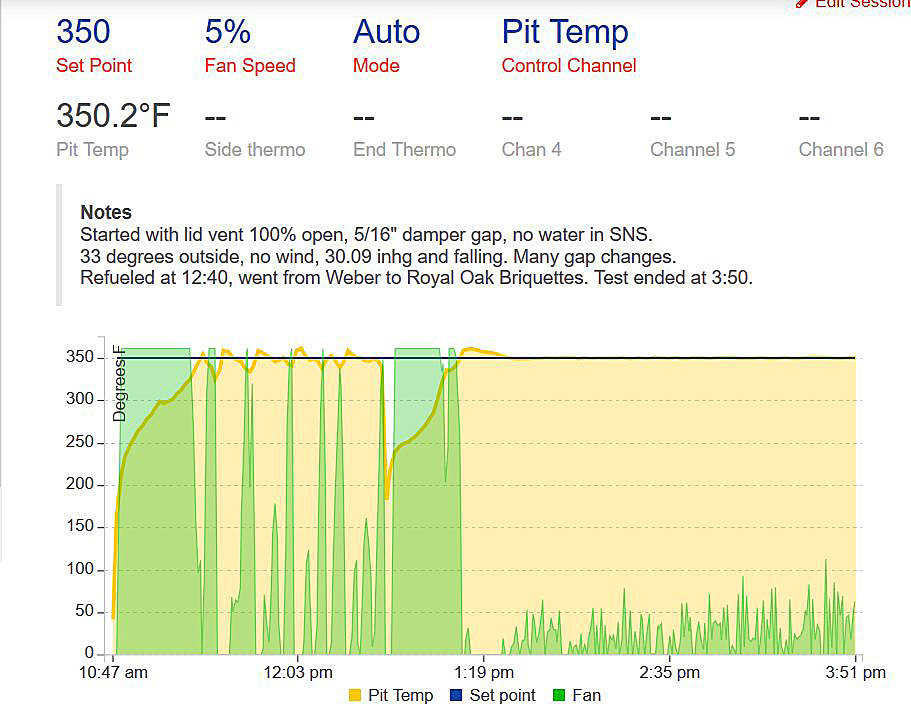Every pit master wants to be able to control their pit’s temperature, and who doesn’t want “set it and forget it”? I want to set it up, fire her off, and come back after my nap. So here we are.
I wanted to smoke some ribs on my Weber Performer recently and while I do have a Slow-N-Sear I always end up chasing the temps to some degree. Since I have the Fireboard thermometer I thought it was time to get a blower since the Fireboard has a fan controller port. So I started searching for threads about using an ATC on a kettle and there just isn’t much out there about how to set one up. Most sites are like “Every smoker is different so you will have to experiment some blah blah blah.” Okay, that’s what I’ll do.
I like the way the BBQ Guru Pit Viper mounts so I purchased that fan and mount and got the special cord from Fireboard. It was all plug-n-play (I love it when that happens). There is also not a lot out there about where to mount a blower on a kettle. I have read that it can’t go below the charcoal grate because of the ash sweepers on the Performer. Well, there are three triangular spots below the grate that the sweepers don’t reach and, depending on what you are after, I’m guessing one of those spots will work for you. I chose one that will allow the fan to blow across the bottom of my SNS because it never leaves my grill. Most who use this blower drill a good size hole for the mount. I wanted a small hole for the attachment screw with 4 larger holes around it exactly like the holes in the mount. That way the mount can’t move around on the bowl. I just lined up the larger holes when I mounted it.



So all mounted and ready for ribs. The Pit Viper has a slide damper that I left wide open and set the fan controller to “Auto”. I fed my thermometer wires through the electrical nipple I had added to the kettle for that purpose and cranked her up. I also had added water to the SNS. Well it didn’t go as I had hoped and I ended up chasing the temps for 2-3 hours, all the while making all kinds of changes. It never got waaaaay out of control and the ribs, which I finished in the oven, were excellent, but I needed to experiment some with the blower. One of the things I learned in that cook is that it takes way less oxygen than you might think to keep a good smoking temp going. At several points I had temperatures rising while the fan was off so I knew the fire was getting oxygen from somewhere so I closed the fan damper some, and then closed it a lot by the cook’s end. I figured the oxygen was going in through the fan even when it was off. I also thought it might be going in through the probe nipple. At the end of the smoke I had the fan damper open to 15/64”. This is where I started my experimentation.


The next day I set up the Performer for another long cook except that I fed my thermometer wires through the lid vent holes, leaving the probe nipple capped. I also left the lid exhaust vent wide open. Some people use the lid vent for temperature control but instead of choking the smoke to limit temps, I’d rather control the oxygen input. It’s also one less thing to deal with. I checked the fan damper opening with a 15/64” drill bit and fired her up. As the graph shows it held my set point of 230* for more than an hour. So at 11:00 I bumped the set point to 240* (only change) and that seemed to hold fine. At noon I bumped the set point to 250*. It went there but the fan seemed to work a bit to stay there because I was running out of fuel.

So I refueled, set the fan damper opening with a 5/16” drill bit, and started a new session. I fired her off and I could see pretty quickly that a 5/16” opening was too much; the fan didn’t start and the temp didn’t want to fall into place. So at about 2:10 I changed the damper gap to 17/64”. The temperature then fell into line and the fan ran minimally to maintain the 250*.

The next day I refueled, set the fan damper for ¼”, opened the exhaust vent wide open, added water, and fired her up. I overshot my set point and while waiting for the temp to come down I could see that the ¼” gap was too much. So I changed the damper gap to 15/64”, changed my set point, and in short order I was holding 250* with very little fan work. I let her go until noon. The Fireboard site lets you download a cook using comma separated values (csv file) which will load into Excel. I downloaded this one. The program checks the temperature every 5 seconds and between 11:00 and 12:00 (when I ran out of fuel) the temperature ranged from 249-251.9 degrees. I’d call that dialed in.

Conclusion:
I am not where I want to be in this kettle as a smoker quest but I am way closer than I was when I cooked the ribs. I’m hoping that my experimentation thus far might give someone else’s quest a better starting point, something I was unable to find online. I do feel confident now that I can maintain any temperature from 230-250* using a 15/64” damper gap, at least in the winter, anyway. Assuming that the pit is tight in all other ways, the fan damper opening seems to be very critical. The difference between the gap openings I’ve been trying is minimal, a mere 16 thousandths between 15/64ths and ¼”. But on my Performer it’s the difference between being in the area and nailing it. My Performer is pretty tight without gaskets and the like but, “Every smoker is different so you will have to experiment some blah blah blah.”
Good luck, and start with a tight kettle if you try this.
I wanted to smoke some ribs on my Weber Performer recently and while I do have a Slow-N-Sear I always end up chasing the temps to some degree. Since I have the Fireboard thermometer I thought it was time to get a blower since the Fireboard has a fan controller port. So I started searching for threads about using an ATC on a kettle and there just isn’t much out there about how to set one up. Most sites are like “Every smoker is different so you will have to experiment some blah blah blah.” Okay, that’s what I’ll do.
I like the way the BBQ Guru Pit Viper mounts so I purchased that fan and mount and got the special cord from Fireboard. It was all plug-n-play (I love it when that happens). There is also not a lot out there about where to mount a blower on a kettle. I have read that it can’t go below the charcoal grate because of the ash sweepers on the Performer. Well, there are three triangular spots below the grate that the sweepers don’t reach and, depending on what you are after, I’m guessing one of those spots will work for you. I chose one that will allow the fan to blow across the bottom of my SNS because it never leaves my grill. Most who use this blower drill a good size hole for the mount. I wanted a small hole for the attachment screw with 4 larger holes around it exactly like the holes in the mount. That way the mount can’t move around on the bowl. I just lined up the larger holes when I mounted it.
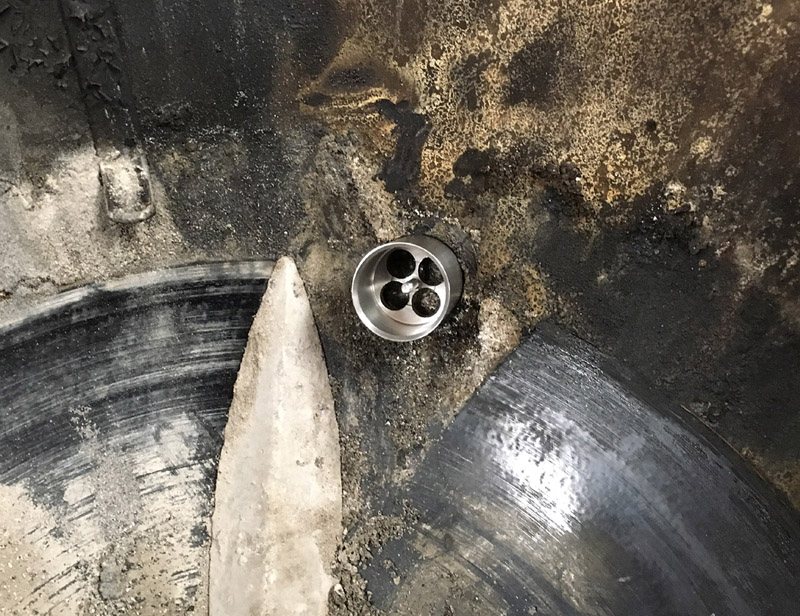

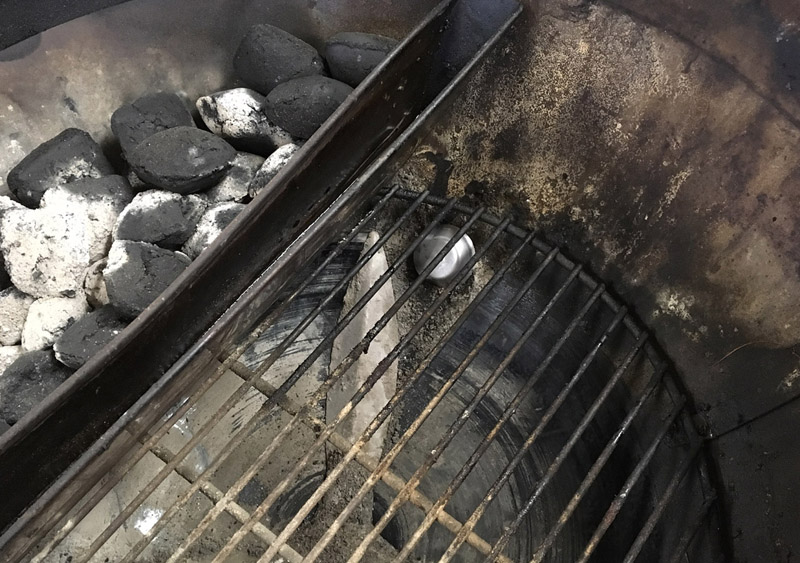
So all mounted and ready for ribs. The Pit Viper has a slide damper that I left wide open and set the fan controller to “Auto”. I fed my thermometer wires through the electrical nipple I had added to the kettle for that purpose and cranked her up. I also had added water to the SNS. Well it didn’t go as I had hoped and I ended up chasing the temps for 2-3 hours, all the while making all kinds of changes. It never got waaaaay out of control and the ribs, which I finished in the oven, were excellent, but I needed to experiment some with the blower. One of the things I learned in that cook is that it takes way less oxygen than you might think to keep a good smoking temp going. At several points I had temperatures rising while the fan was off so I knew the fire was getting oxygen from somewhere so I closed the fan damper some, and then closed it a lot by the cook’s end. I figured the oxygen was going in through the fan even when it was off. I also thought it might be going in through the probe nipple. At the end of the smoke I had the fan damper open to 15/64”. This is where I started my experimentation.

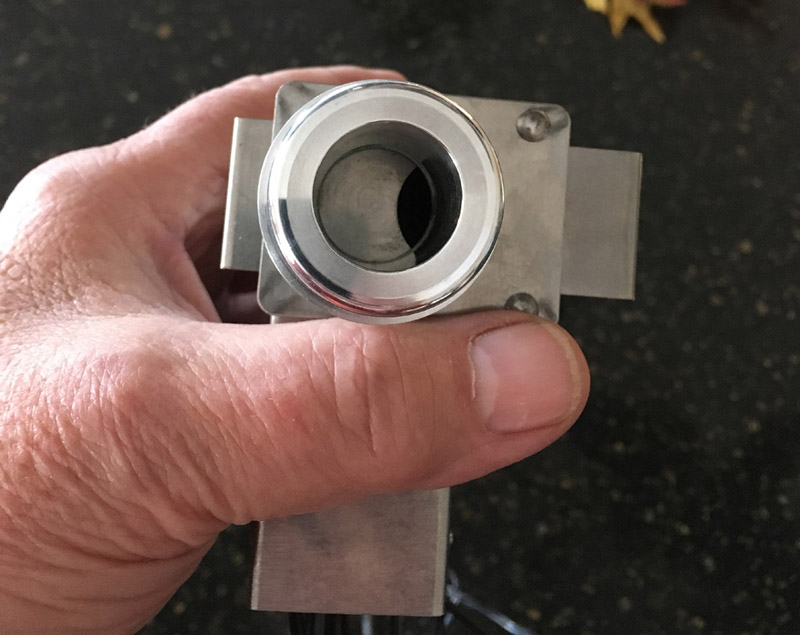
The next day I set up the Performer for another long cook except that I fed my thermometer wires through the lid vent holes, leaving the probe nipple capped. I also left the lid exhaust vent wide open. Some people use the lid vent for temperature control but instead of choking the smoke to limit temps, I’d rather control the oxygen input. It’s also one less thing to deal with. I checked the fan damper opening with a 15/64” drill bit and fired her up. As the graph shows it held my set point of 230* for more than an hour. So at 11:00 I bumped the set point to 240* (only change) and that seemed to hold fine. At noon I bumped the set point to 250*. It went there but the fan seemed to work a bit to stay there because I was running out of fuel.
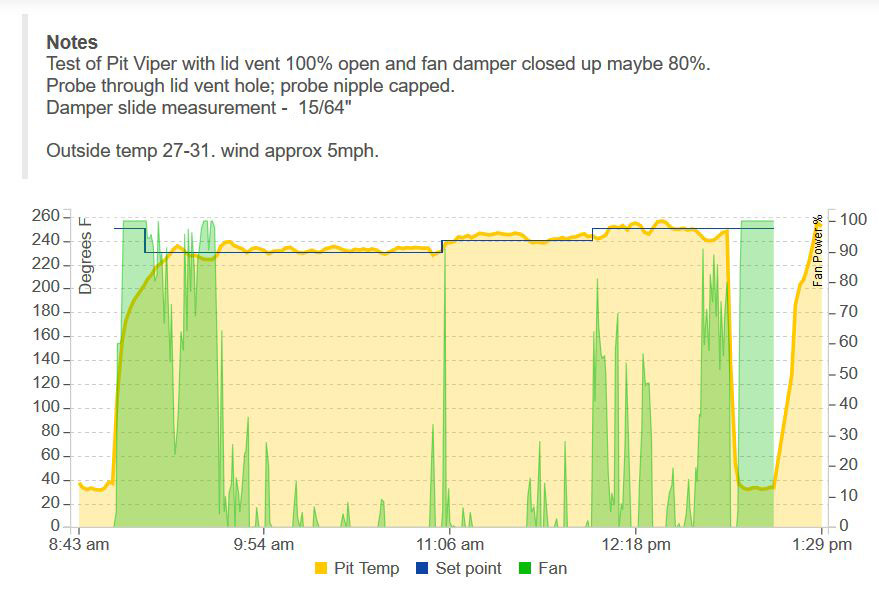
So I refueled, set the fan damper opening with a 5/16” drill bit, and started a new session. I fired her off and I could see pretty quickly that a 5/16” opening was too much; the fan didn’t start and the temp didn’t want to fall into place. So at about 2:10 I changed the damper gap to 17/64”. The temperature then fell into line and the fan ran minimally to maintain the 250*.
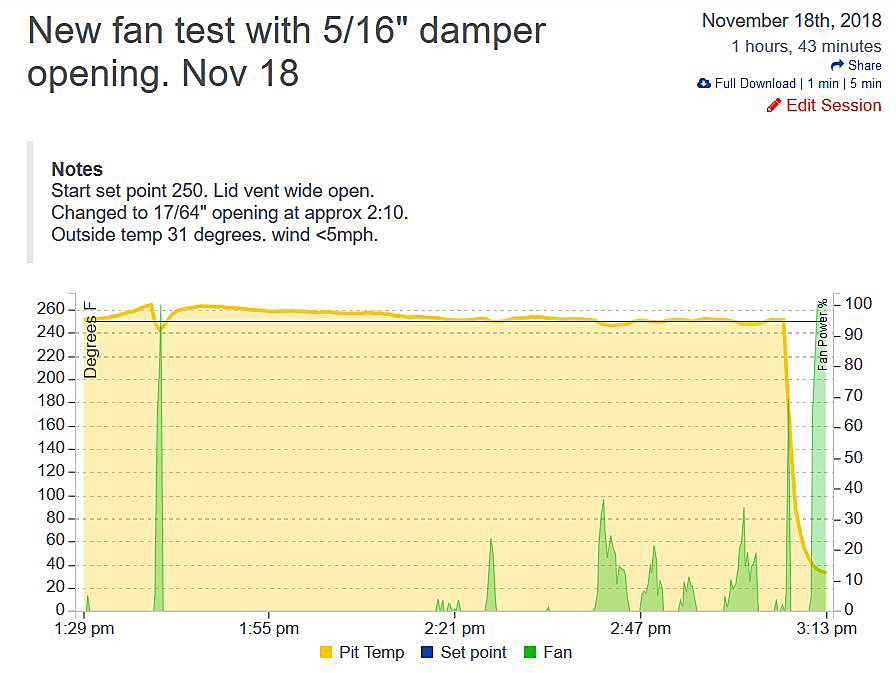
The next day I refueled, set the fan damper for ¼”, opened the exhaust vent wide open, added water, and fired her up. I overshot my set point and while waiting for the temp to come down I could see that the ¼” gap was too much. So I changed the damper gap to 15/64”, changed my set point, and in short order I was holding 250* with very little fan work. I let her go until noon. The Fireboard site lets you download a cook using comma separated values (csv file) which will load into Excel. I downloaded this one. The program checks the temperature every 5 seconds and between 11:00 and 12:00 (when I ran out of fuel) the temperature ranged from 249-251.9 degrees. I’d call that dialed in.
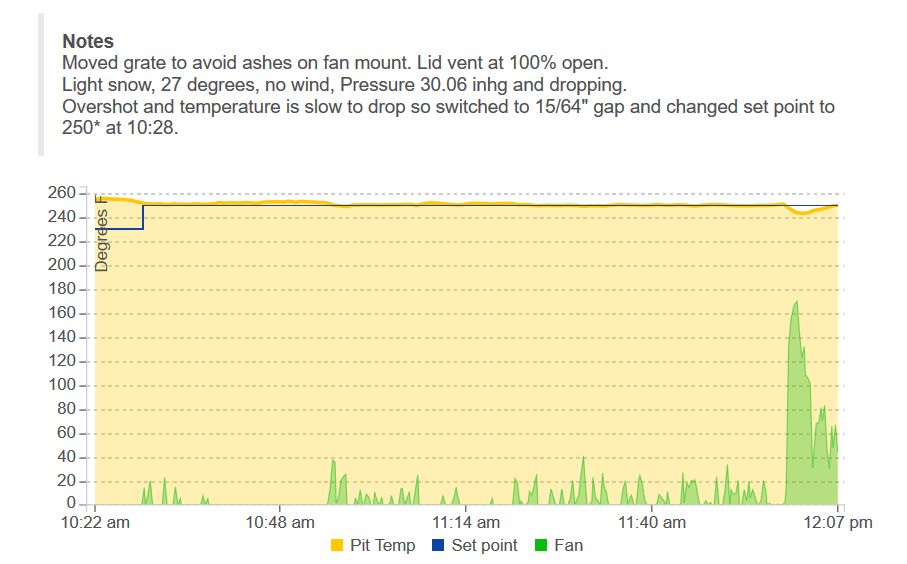
Conclusion:
I am not where I want to be in this kettle as a smoker quest but I am way closer than I was when I cooked the ribs. I’m hoping that my experimentation thus far might give someone else’s quest a better starting point, something I was unable to find online. I do feel confident now that I can maintain any temperature from 230-250* using a 15/64” damper gap, at least in the winter, anyway. Assuming that the pit is tight in all other ways, the fan damper opening seems to be very critical. The difference between the gap openings I’ve been trying is minimal, a mere 16 thousandths between 15/64ths and ¼”. But on my Performer it’s the difference between being in the area and nailing it. My Performer is pretty tight without gaskets and the like but, “Every smoker is different so you will have to experiment some blah blah blah.”
Good luck, and start with a tight kettle if you try this.


